Science
Verbal Flatulence
Clare Collins, a professor of nutrition at the University of Newcastle in Australia, has recently been making headlines for an article she wrote in The Conversation in which she claimed that if you hold in a fart too long some of it will eventually come out your mouth:To back up this claim she cites a 2010 article in the journal Digestive Diseases and Sciences, and this article does indeed say this:
However, it's hydrogen sulfide, H2S, that makes farts smell, and according to the article, this isn't excreted in your breath: "Once in circulation, H2S is excreted primarily by the kidneys as free or conjugated sulfate."
Posted By: Alex - Sat Oct 06, 2018 -
Comments (4)
Category: Science, Flatulence
Blue Jay Emetic Unit
As defined by biologist Lincoln Brower, a "blue jay emetic unit" is the amount of cardiac glycosides (a type of poison found in plants such as milkweeds) that will make one blue jay vomit. Brower determined the exact amount by putting cardiac glycosides into gelatin capsules which he force-fed to blue jays.The point of this was that various butterflies ate milkweeds and then became poisonous to the blue jays which, in turn, ate them. Knowing the exact amount of poison needed to make a blue jay vomit allowed Brower to rank each butterfly by its number of blue jay emetic units:
Source: Brower LP (Feb 1969). "Ecological Chemistry." Scientific American 220(2): 22-29.
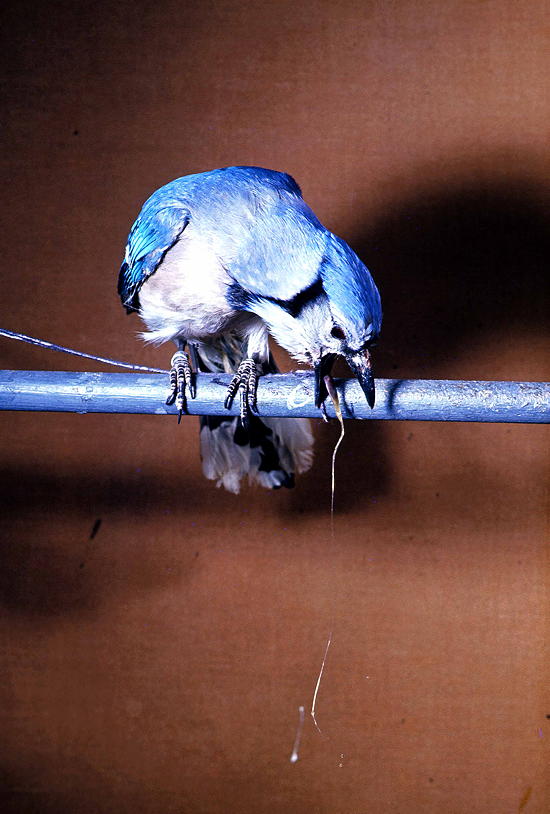
"barfing blue jay" (picture by Lincoln Brower. Source: ScienceFriday.com)
Posted By: Alex - Wed Oct 03, 2018 -
Comments (3)
Category: Nature, Science, Experiments
The Initials Effect
Found by psychologist Nicholas Christenfeld. The effect is that if the initials of your name spell out something positive (such as J.O.Y. or G.O.D.) you'll likely live longer than someone whose initials spell out something negative (B.A.D. or A.S.S.).From his article in the Journal of Psychomatic Research (Sep 1999):
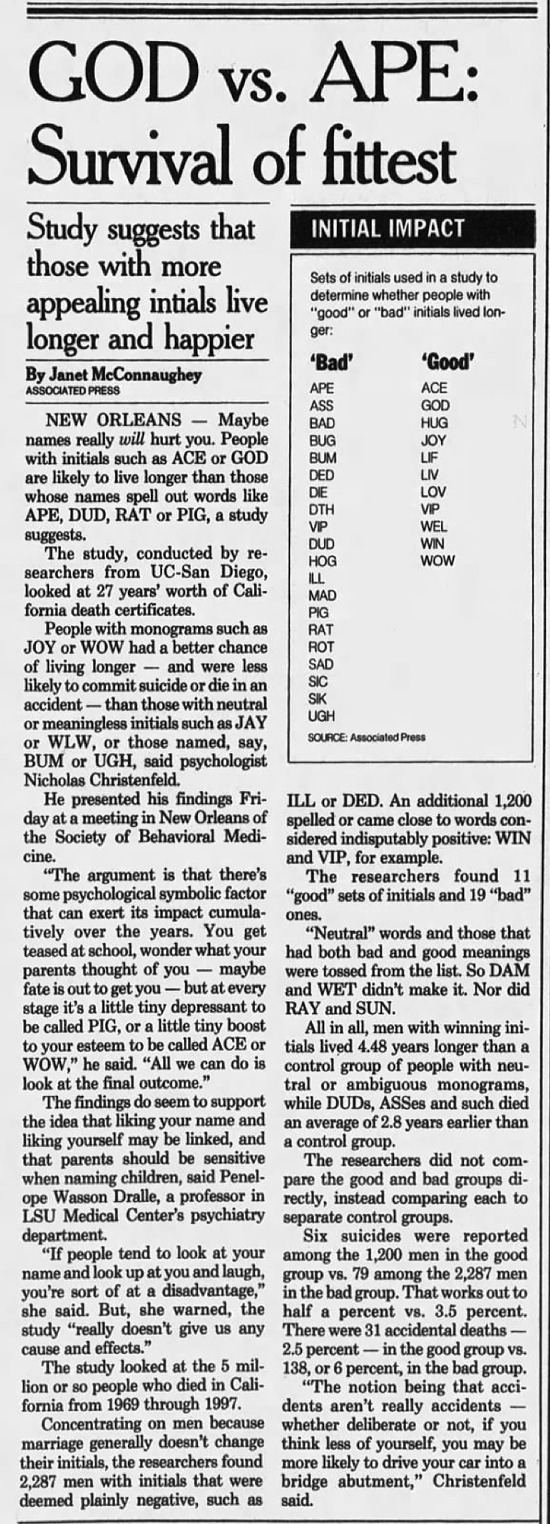
San Francisco Examiner - Mar 28, 1998
Posted By: Alex - Wed Sep 05, 2018 -
Comments (4)
Category: Odd Names, Science, Psychology
Making a silk purse from a sow’s ear
Back in 1921, the chemist Arthur D. Little took it upon himself to make a silk purse out of a sow's ear. Or rather, he figured out a way to produce a silk-like thread out of sows' ears and wove a purse from this.Actually, he made two purses. The Smithsonian has one of them. MIT now has the other. (Little was an MIT grad).
The picture of the purse (below) looks nothing like the illustration of it. I wonder what happened. Did the dye fade, or something?
More info: MIT Museum, MIT Library

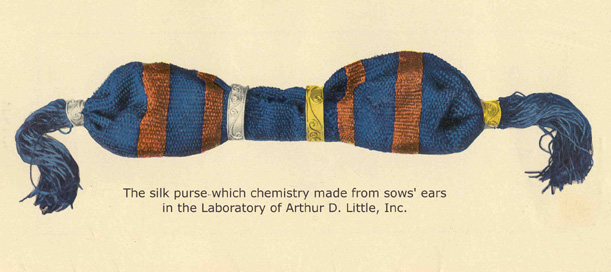


Pittsburgh Press - Dec 28, 1975
Posted By: Alex - Sun Aug 19, 2018 -
Comments (1)
Category: Animals, Science, 1920s
Chilling big toe cures runny nose
As reported by Israeli scientists Dr. Menahem Ram and Aladar Schwartz at a 1971 joint meeting of the Society for Cryobiology and the International Conference of Refrigeration:
Newport News Daily Press - Sep 3, 1971
Posted By: Alex - Thu Aug 16, 2018 -
Comments (6)
Category: Mad Scientists, Evil Geniuses, Insane Villains, Medicine, Cures for the common cold, Science, 1970s, Feet
Does seltzer water help plants grow?
In 1980, Canfield's natural seltzer launched a campaign to promote its product as being great for watering house plants. It printed on its labels: "We recommend our natural seltzer for house plants."Could there have been any truth to this claim? Is seltzer water actually good for plants? Well, the only vaguely scientific study I can find addressing this claim (after, admittedly, only a brief search) was a student project conducted at the University of Colorado Boulder in 2002. The student researchers concluded, "Plants given carbonated water not only grew faster but also developed a healthier shade of green in comparison to plants given tap water."
So, maybe Canfield's was onto something. However, if you're thinking of treating your plants to some seltzer water, I imagine you'd want to use water at room temperature, not refrigerated. Cold water might shock their systems.
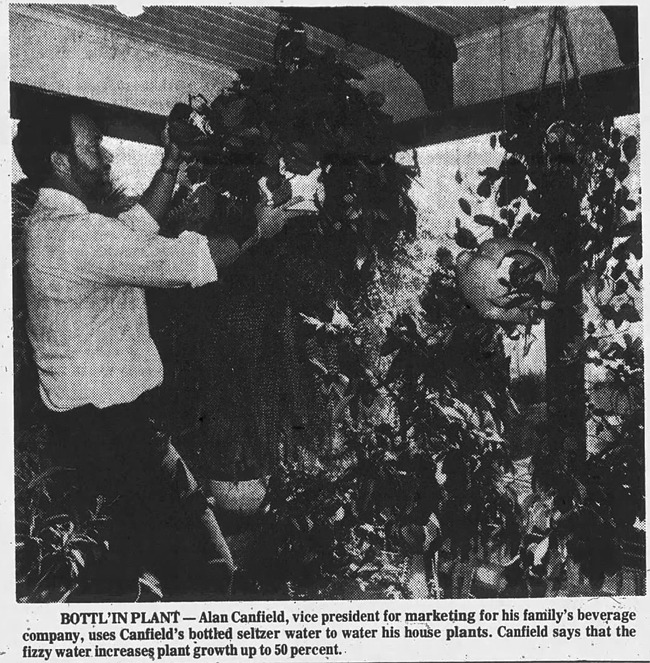
Marysville Journal-Tribune - June 9, 1980
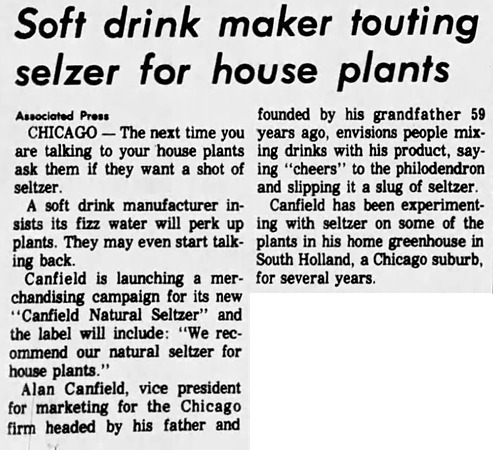
Owensboro Messenger-Inquirer - May 19, 1980
Posted By: Alex - Thu Jul 19, 2018 -
Comments (12)
Category: Nature, Science, Environmentalism and Ecology, Experiments, 1980s
Urine crystal bling
Fashion student Alice Potts has hit on the idea of adding some bling to clothes by embellishing them with crystals formed from bodily excretions such as sweat and urine. She says, "Instead of using plastic accessories to maybe embellish garments ... we can start like growing onto our garments these new materials and more natural materials."Her website: http://www.alicepotts.com
More info: Huff Post


I'm assuming she must have made the crystals using a technique similar to the one outlined in the video below. She just added urine or sweat in addition to the other ingredients.
Posted By: Alex - Wed Jul 11, 2018 -
Comments (2)
Category: Fashion, Science
Light Is Invisible

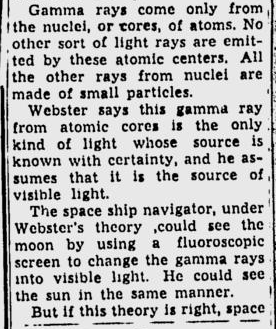
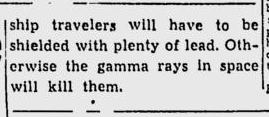
Original article here.
Posted By: Paul - Sat Feb 17, 2018 -
Comments (7)
Category: Eccentrics, Science, Spaceflight, Astronautics, and Astronomy, 1940s
Lawyer consumption rates of Tyrannosaurus rex
A science question inspired by the scene in Jurassic Park in which the T rex ate the lawyer:How many lawyers would it take to properly feed a captive T rex for an entire year?
The answer: if the T rex is warm-blooded it will need to eat 292 lawyers a year. If cold-blooded, only 73 lawyers.
From The Complete Dinosaur, edited by James Orville Farlow, M. K. Brett-Surman.


Posted By: Alex - Tue Jan 23, 2018 -
Comments (3)
Category: Law, Science, Dinosaurs and Other Extinct Creatures
Service for smiles
Given an equal choice, will a store clerk first serve a smiling or a frowning customer?Science provides the answer. Clerks go toward the smiler.
Maybe this is why it's so hard to ever get help in Home Depot. I need to be grinning more.

Elmira Star Gazette - Dec 11, 1972
Posted By: Alex - Thu Nov 30, 2017 -
Comments (3)
Category: Science, Psychology, Shopping

| Who We Are |
|---|
| Alex Boese Alex is the creator and curator of the Museum of Hoaxes. He's also the author of various weird, non-fiction, science-themed books such as Elephants on Acid and Psychedelic Apes. Paul Di Filippo Paul has been paid to put weird ideas into fictional form for over thirty years, in his career as a noted science fiction writer. He has recently begun blogging on many curious topics with three fellow writers at The Inferior 4+1. Contact Us |




